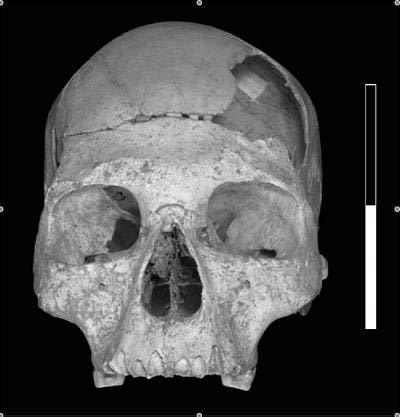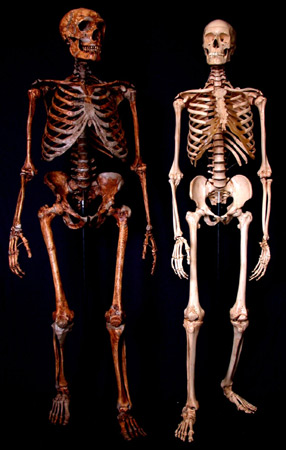Strange Old Skull: Human or Not?

A strange ancient skull recently uncovered adds to mounting evidence that humans and Neanderthals interbred and suggests that humans evolved considerably after settling the European continent some 40,000 years ago.
Modern humans emerged from Africa about 150,000 years ago, according to the leading theory (which has been challenged in recent years). The newfound skull is thought to be from sometime in the first 5,000 years of human habitation of Europe.
The skull [image] is unlike anything previously dug up.
Researchers led by Joao Zilhao of the University of Bristol and Erik Trinkaus of Washington University compared the features of the cranium, found in a cave in southwestern Romania, with other human samples from the time.
The reconstructed cranium is called Oase 2. Radiocarbon dating revealed only that it is at least 35,000 years old. But its mandible is similar to Oase 1, found previously at the surface of the cave and dated more firmly to about 40,500 years ago. The team has concluded that both fossils are the same age.
These are the earliest modern human remains so far found in Europe.
Odd skull
Sign up for the Live Science daily newsletter now
Get the world’s most fascinating discoveries delivered straight to your inbox.
Oase 2 has the same proportions as modern human craniums and has other features that are non-Neanderthal. But other features are unusual for a modern human, the scientists say. These include a retreating forehead and exceptionally large upper molars found principally among the Neanderthals.
"Technically, this skull is a modern human, but humans as we know them today have evolved considerably since then," Trinkaus said.
"Such differences raise important questions about the evolutionary history of modern humans," Zilhao said. "They could be the result of evolutionary reversal or reflect incomplete palaeontological sampling of Middle Paleolithic human diversity. They could also reflect admixture with Neanderthal populations as modern humans spread through western Eurasia. This mixture would have resulted in both archaic traits retained from the Neanderthals and unique combinations of traits resulting from the blending of previously divergent gene pools."
Questions remain
Trinkaus announced similar evidence of human-Neanderthal intermingling in October.
Some researchers have questioned whether humans and Neanderthals ever met, however. More bones must be found to fill in the time gaps and settle the questions, the researchers said.
"This fossil is a major addition to the growing body of fossil, genetic and archaeological evidence indicating significant levels of biological and cultural interaction between modern humans and the anatomically archaic populations (including the Neanderthals) they met along the way as they spread from Africa into Eurasia," Zilhao said.
The findings are detailed this week in the Proceedings of the National Academy of Sciences.
More on Human Evolution
- Top 10 Missing Links
- Humans Still Evolving
- Peace or War? How Early Humans Behaved
- When Humans and Chimps Split
- All About Evolution
More about Neanderthals
- Neanderthal: 99.5 Percent Human
- Scientists Build 'Frankenstein' Neanderthal Skeleton
- Scientist: Humans Strange, Neanderthals Normal
Humans & Neanderthals

Robert is an independent health and science journalist and writer based in Phoenix, Arizona. He is a former editor-in-chief of Live Science with over 20 years of experience as a reporter and editor. He has worked on websites such as Space.com and Tom's Guide, and is a contributor on Medium, covering how we age and how to optimize the mind and body through time. He has a journalism degree from Humboldt State University in California.










